Umut Şimşekli
On the Interaction of Compressibility and Adversarial Robustness
Jul 23, 2025Abstract:Modern neural networks are expected to simultaneously satisfy a host of desirable properties: accurate fitting to training data, generalization to unseen inputs, parameter and computational efficiency, and robustness to adversarial perturbations. While compressibility and robustness have each been studied extensively, a unified understanding of their interaction still remains elusive. In this work, we develop a principled framework to analyze how different forms of compressibility - such as neuron-level sparsity and spectral compressibility - affect adversarial robustness. We show that these forms of compression can induce a small number of highly sensitive directions in the representation space, which adversaries can exploit to construct effective perturbations. Our analysis yields a simple yet instructive robustness bound, revealing how neuron and spectral compressibility impact $L_\infty$ and $L_2$ robustness via their effects on the learned representations. Crucially, the vulnerabilities we identify arise irrespective of how compression is achieved - whether via regularization, architectural bias, or implicit learning dynamics. Through empirical evaluations across synthetic and realistic tasks, we confirm our theoretical predictions, and further demonstrate that these vulnerabilities persist under adversarial training and transfer learning, and contribute to the emergence of universal adversarial perturbations. Our findings show a fundamental tension between structured compressibility and robustness, and suggest new pathways for designing models that are both efficient and secure.
Mutual Information Free Topological Generalization Bounds via Stability
Jul 09, 2025Abstract:Providing generalization guarantees for stochastic optimization algorithms is a major challenge in modern learning theory. Recently, several studies highlighted the impact of the geometry of training trajectories on the generalization error, both theoretically and empirically. Among these works, a series of topological generalization bounds have been proposed, relating the generalization error to notions of topological complexity that stem from topological data analysis (TDA). Despite their empirical success, these bounds rely on intricate information-theoretic (IT) terms that can be bounded in specific cases but remain intractable for practical algorithms (such as ADAM), potentially reducing the relevance of the derived bounds. In this paper, we seek to formulate comprehensive and interpretable topological generalization bounds free of intractable mutual information terms. To this end, we introduce a novel learning theoretic framework that departs from the existing strategies via proof techniques rooted in algorithmic stability. By extending an existing notion of \textit{hypothesis set stability}, to \textit{trajectory stability}, we prove that the generalization error of trajectory-stable algorithms can be upper bounded in terms of (i) TDA quantities describing the complexity of the trajectory of the optimizer in the parameter space, and (ii) the trajectory stability parameter of the algorithm. Through a series of experimental evaluations, we demonstrate that the TDA terms in the bound are of great importance, especially as the number of training samples grows. This ultimately forms an explanation of the empirical success of the topological generalization bounds.
Topological Generalization Bounds for Discrete-Time Stochastic Optimization Algorithms
Jul 11, 2024
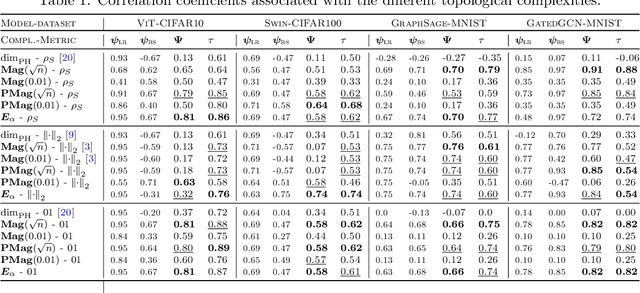


Abstract:We present a novel set of rigorous and computationally efficient topology-based complexity notions that exhibit a strong correlation with the generalization gap in modern deep neural networks (DNNs). DNNs show remarkable generalization properties, yet the source of these capabilities remains elusive, defying the established statistical learning theory. Recent studies have revealed that properties of training trajectories can be indicative of generalization. Building on this insight, state-of-the-art methods have leveraged the topology of these trajectories, particularly their fractal dimension, to quantify generalization. Most existing works compute this quantity by assuming continuous- or infinite-time training dynamics, complicating the development of practical estimators capable of accurately predicting generalization without access to test data. In this paper, we respect the discrete-time nature of training trajectories and investigate the underlying topological quantities that can be amenable to topological data analysis tools. This leads to a new family of reliable topological complexity measures that provably bound the generalization error, eliminating the need for restrictive geometric assumptions. These measures are computationally friendly, enabling us to propose simple yet effective algorithms for computing generalization indices. Moreover, our flexible framework can be extended to different domains, tasks, and architectures. Our experimental results demonstrate that our new complexity measures correlate highly with generalization error in industry-standards architectures such as transformers and deep graph networks. Our approach consistently outperforms existing topological bounds across a wide range of datasets, models, and optimizers, highlighting the practical relevance and effectiveness of our complexity measures.
Differential Privacy of Noisy GD under Heavy-Tailed Perturbations
Mar 04, 2024Abstract:Injecting heavy-tailed noise to the iterates of stochastic gradient descent (SGD) has received increasing attention over the past few years. While various theoretical properties of the resulting algorithm have been analyzed mainly from learning theory and optimization perspectives, their privacy preservation properties have not yet been established. Aiming to bridge this gap, we provide differential privacy (DP) guarantees for noisy SGD, when the injected noise follows an $\alpha$-stable distribution, which includes a spectrum of heavy-tailed distributions (with infinite variance) as well as the Gaussian distribution. Considering the $(\epsilon, \delta)$-DP framework, we show that SGD with heavy-tailed perturbations achieves $(0, \tilde{\mathcal{O}}(1/n))$-DP for a broad class of loss functions which can be non-convex, where $n$ is the number of data points. As a remarkable byproduct, contrary to prior work that necessitates bounded sensitivity for the gradients or clipping the iterates, our theory reveals that under mild assumptions, such a projection step is not actually necessary. We illustrate that the heavy-tailed noising mechanism achieves similar DP guarantees compared to the Gaussian case, which suggests that it can be a viable alternative to its light-tailed counterparts.
Generalization Bounds for Heavy-Tailed SDEs through the Fractional Fokker-Planck Equation
Feb 12, 2024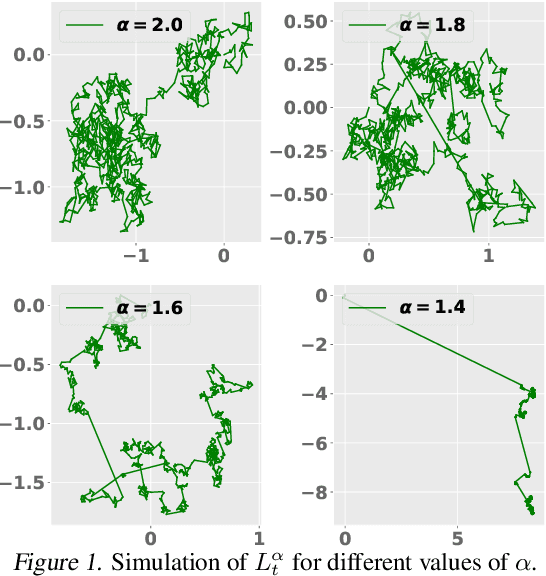
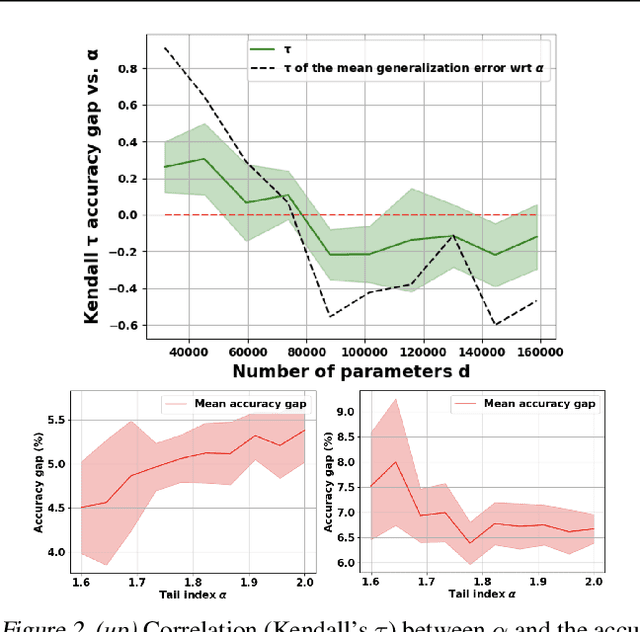
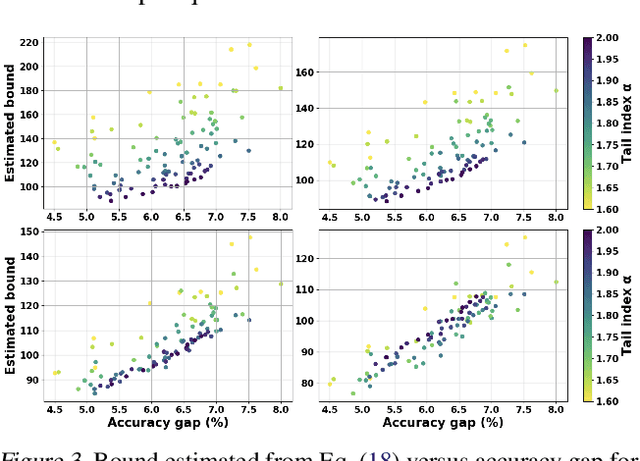
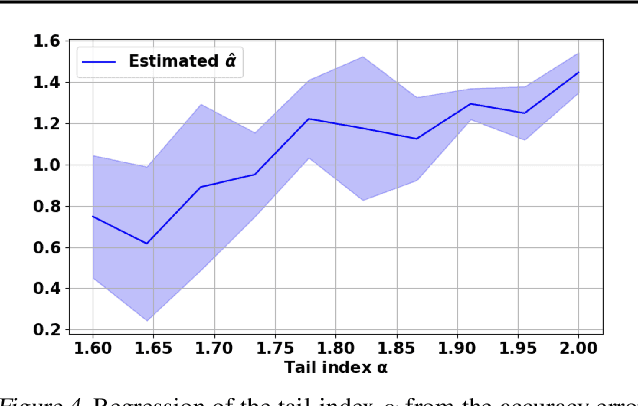
Abstract:Understanding the generalization properties of heavy-tailed stochastic optimization algorithms has attracted increasing attention over the past years. While illuminating interesting aspects of stochastic optimizers by using heavy-tailed stochastic differential equations as proxies, prior works either provided expected generalization bounds, or introduced non-computable information theoretic terms. Addressing these drawbacks, in this work, we prove high-probability generalization bounds for heavy-tailed SDEs which do not contain any nontrivial information theoretic terms. To achieve this goal, we develop new proof techniques based on estimating the entropy flows associated with the so-called fractional Fokker-Planck equation (a partial differential equation that governs the evolution of the distribution of the corresponding heavy-tailed SDE). In addition to obtaining high-probability bounds, we show that our bounds have a better dependence on the dimension of parameters as compared to prior art. Our results further identify a phase transition phenomenon, which suggests that heavy tails can be either beneficial or harmful depending on the problem structure. We support our theory with experiments conducted in a variety of settings.
Tighter Generalisation Bounds via Interpolation
Feb 07, 2024



Abstract:This paper contains a recipe for deriving new PAC-Bayes generalisation bounds based on the $(f, \Gamma)$-divergence, and, in addition, presents PAC-Bayes generalisation bounds where we interpolate between a series of probability divergences (including but not limited to KL, Wasserstein, and total variation), making the best out of many worlds depending on the posterior distributions properties. We explore the tightness of these bounds and connect them to earlier results from statistical learning, which are specific cases. We also instantiate our bounds as training objectives, yielding non-trivial guarantees and practical performances.
Efficient Sampling of Stochastic Differential Equations with Positive Semi-Definite Models
Mar 30, 2023Abstract:This paper deals with the problem of efficient sampling from a stochastic differential equation, given the drift function and the diffusion matrix. The proposed approach leverages a recent model for probabilities \citep{rudi2021psd} (the positive semi-definite -- PSD model) from which it is possible to obtain independent and identically distributed (i.i.d.) samples at precision $\varepsilon$ with a cost that is $m^2 d \log(1/\varepsilon)$ where $m$ is the dimension of the model, $d$ the dimension of the space. The proposed approach consists in: first, computing the PSD model that satisfies the Fokker-Planck equation (or its fractional variant) associated with the SDE, up to error $\varepsilon$, and then sampling from the resulting PSD model. Assuming some regularity of the Fokker-Planck solution (i.e. $\beta$-times differentiability plus some geometric condition on its zeros) We obtain an algorithm that: (a) in the preparatory phase obtains a PSD model with L2 distance $\varepsilon$ from the solution of the equation, with a model of dimension $m = \varepsilon^{-(d+1)/(\beta-2s)} (\log(1/\varepsilon))^{d+1}$ where $0<s\leq1$ is the fractional power to the Laplacian, and total computational complexity of $O(m^{3.5} \log(1/\varepsilon))$ and then (b) for Fokker-Planck equation, it is able to produce i.i.d.\ samples with error $\varepsilon$ in Wasserstein-1 distance, with a cost that is $O(d \varepsilon^{-2(d+1)/\beta-2} \log(1/\varepsilon)^{2d+3})$ per sample. This means that, if the probability associated with the SDE is somewhat regular, i.e. $\beta \geq 4d+2$, then the algorithm requires $O(\varepsilon^{-0.88} \log(1/\varepsilon)^{4.5d})$ in the preparatory phase, and $O(\varepsilon^{-1/2}\log(1/\varepsilon)^{2d+2})$ for each sample. Our results suggest that as the true solution gets smoother, we can circumvent the curse of dimensionality without requiring any sort of convexity.
Cyclic and Randomized Stepsizes Invoke Heavier Tails in SGD
Feb 10, 2023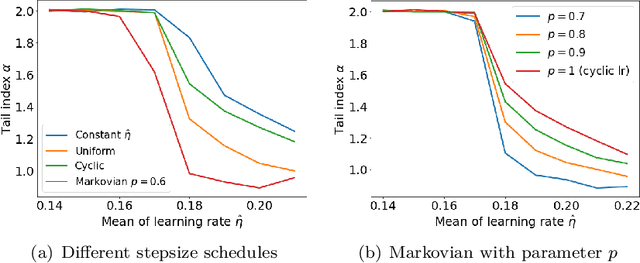
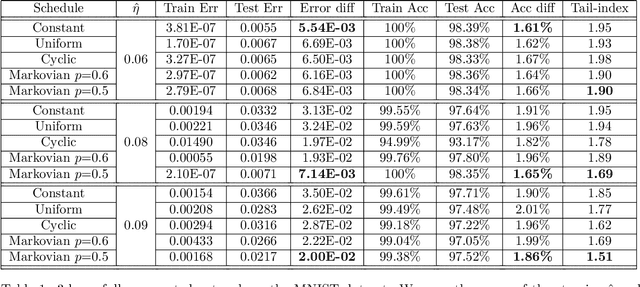

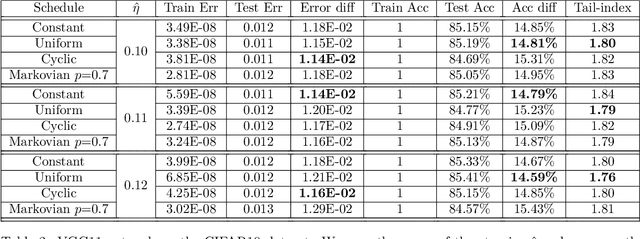
Abstract:Cyclic and randomized stepsizes are widely used in the deep learning practice and can often outperform standard stepsize choices such as constant stepsize in SGD. Despite their empirical success, not much is currently known about when and why they can theoretically improve the generalization performance. We consider a general class of Markovian stepsizes for learning, which contain i.i.d. random stepsize, cyclic stepsize as well as the constant stepsize as special cases, and motivated by the literature which shows that heaviness of the tails (measured by the so-called "tail-index") in the SGD iterates is correlated with generalization, we study tail-index and provide a number of theoretical results that demonstrate how the tail-index varies on the stepsize scheduling. Our results bring a new understanding of the benefits of cyclic and randomized stepsizes compared to constant stepsize in terms of the tail behavior. We illustrate our theory on linear regression experiments and show through deep learning experiments that Markovian stepsizes can achieve even a heavier tail and be a viable alternative to cyclic and i.i.d. randomized stepsize rules.
Generalization Bounds with Data-dependent Fractal Dimensions
Feb 06, 2023



Abstract:Providing generalization guarantees for modern neural networks has been a crucial task in statistical learning. Recently, several studies have attempted to analyze the generalization error in such settings by using tools from fractal geometry. While these works have successfully introduced new mathematical tools to apprehend generalization, they heavily rely on a Lipschitz continuity assumption, which in general does not hold for neural networks and might make the bounds vacuous. In this work, we address this issue and prove fractal geometry-based generalization bounds without requiring any Lipschitz assumption. To achieve this goal, we build up on a classical covering argument in learning theory and introduce a data-dependent fractal dimension. Despite introducing a significant amount of technical complications, this new notion lets us control the generalization error (over either fixed or random hypothesis spaces) along with certain mutual information (MI) terms. To provide a clearer interpretation to the newly introduced MI terms, as a next step, we introduce a notion of "geometric stability" and link our bounds to the prior art. Finally, we make a rigorous connection between the proposed data-dependent dimension and topological data analysis tools, which then enables us to compute the dimension in a numerically efficient way. We support our theory with experiments conducted on various settings.
Algorithmic Stability of Heavy-Tailed SGD with General Loss Functions
Jan 30, 2023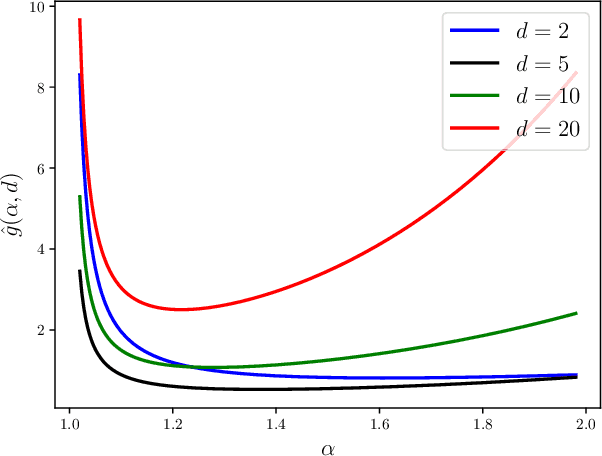
Abstract:Heavy-tail phenomena in stochastic gradient descent (SGD) have been reported in several empirical studies. Experimental evidence in previous works suggests a strong interplay between the heaviness of the tails and generalization behavior of SGD. To address this empirical phenomena theoretically, several works have made strong topological and statistical assumptions to link the generalization error to heavy tails. Very recently, new generalization bounds have been proven, indicating a non-monotonic relationship between the generalization error and heavy tails, which is more pertinent to the reported empirical observations. While these bounds do not require additional topological assumptions given that SGD can be modeled using a heavy-tailed stochastic differential equation (SDE), they can only apply to simple quadratic problems. In this paper, we build on this line of research and develop generalization bounds for a more general class of objective functions, which includes non-convex functions as well. Our approach is based on developing Wasserstein stability bounds for heavy-tailed SDEs and their discretizations, which we then convert to generalization bounds. Our results do not require any nontrivial assumptions; yet, they shed more light to the empirical observations, thanks to the generality of the loss functions.
 Add to Chrome
Add to Chrome Add to Firefox
Add to Firefox Add to Edge
Add to Edge